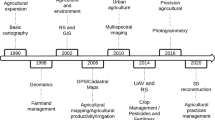Abstract
This paper discusses an iconmap-based visualization technique that enables multiple geospatial variables to be illustrated in a single GIS raster layer. This is achieved by extending the conventional pixel-based data structure to an iconic design. In this way, spatial patterns generated by the interaction of geographic variables can be disclosed, and geospatial information mining can be readily achieved. As a case study, a visual analysis of soil organic matter and soil nutrients for Shuangliu County in the city of Chengdu, China, was undertaken using the prototype IconMapper software, developed by the authors. The results show that the static IconMap can accurately exhibit trends in the distribution of organic matter and nutrients in soil. The dynamic iconmap can both reflect interaction patterns between organic matter and the nutrient variables, and display soil fertility levels in a comprehensive way. Thus, the iconmap-based visualization approach is shown to be a non-fused, exploratory analytical approach for multivariate data analysis and as a result is a valuable method for visually analyzing soil fertility conditions.
Similar content being viewed by others
References
Mitasova H, Harmon R S, Weaver K J, et al. Scientific visualization of landscapes and landforms. Geomorphology, 2011, doi:10.1016/j.geomorph.2010.09.033
De Chiara D, Fatto V D, Laurini R, et al. A chorem-based approach for visually analyzing spatial data. J Visual Lang Comput, 2011, 22: 173–193
Xu B, Lin H, Chiu L, et al. Collaborative virtual geographic environments: a case study of air pollution simulation. Inform Sciences, 2011, 181: 2231–2246
Kulawiak M, Prospathopoulos A, Perivoliotis L, et al. Interactive visualization of marine pollution monitoring and forecasting data via a Web-based GIS. Comput Geosci-UK, 2010, doi:10.1016/j.cageo.2010.02.008
Ropinski T, Oeltze S, Preim B. Survey of glyph-based visualization techniques for spatial multivariate medical data. Comput Graph, 2011, 35: 392–401
Zhang X, Pazner M. The icon imagemap technique for multivariate geospatial data visualization: approach and software system. Cartogr Geogr Inf Sci, 2004, 31: 29–41
Pazner M, Lafreniere M. GIS icon maps. In: ACSM/ASPRS Annual Convention and Exposition, Technical Papers Volume 5: Auto-Carto 13. Seattle: American Society for Photogrammetry and Remote Sensing and American Congress on Surveying and Mapping, 1997. 126–135
Lorenz H, Dollner J. 3D feature surface properties and their application in geovisualization. Comput Environ Urban Syst, 2010, 34: 476–483
van Lammeren R, Houtkamp J, Colijn S, et al. Affective appraisal of 3D land use visualization. Comput Environ Urban Syst, 2010, 34: 465–475
Brooks S, Whalley J L. Multilayer hybrid visualizations to support 3D GIS. Comput Environ Urban Syst, 2008, 32: 278–292
Ning J. Design and development of a 3D visualization system for gravity field models: WHU-3D gravit. Geomat Inf Sci Wuhan Univ, 2007, 32: 945–949
Hildebrandt D, Dollner J. Service-oriented, standards-based 3D geovisualization: potential and challenges. Comput Environ Urban Syst, 2010, 34: 484–495
Jia Z, Liu Y, Zhang T. Design and development of system based on visual interactive spatial data mining. Geomat Inf Sci Wuhan Univ, 2006, 31: 916–919
Schroeder W, Martin K, Lorensen B. The Visualization Toolkit. 2nd ed. USA: Prentice Hall Inc., 1997
Keim D A. Visualization and data. In: Widom J, ed. Proceedings of the 1996 ACM SIGMOD International Conference on Management of Data. Montreal: ACM Press, 1996. 543
Chan A, MacLean K, McGrenere J. Designing haptic icons to support collaborative turn-taking. Int J Hum-Comput St, 2008, 66: 333–355
Dovey D. Vector plots for irregular grids. In: Nielson G M, Silver D, eds. Proceedings of the 6th IEEE Visualization Conference (Visualization’95). Atlanta: IEEE Computer Society, 1995. 248–253
Horton W. The Icon Book: Visual Symbols for Computer Systems and Documentation. New York: John Wiley & Sons Inc., 1994
Yaman M, Härting M, Nsengiyumva S, Britton D T. Scientific visualization: analysis, exploration and presentation of tri-axial stress states of Kr implanted titanium determined by X-ray diffraction. Surface Coat Technol, 2007, 201: 8431–8436
Wood M. The traditional map as a visualization technique. In: Hearbshaw H, Unwin D, eds. Visualization in Geographical Information Systems. England: John Wiley & Sons Ltd., 1997. 9–17
Walsum T V, Post F H, Silver D, et al. Feature extraction and iconic visualization. IEEE Trans Vis Comput Gr, 1997, 2: 111–119
Kolhoff P, Preuß J, Loviscach J. Content-based icons for music files. Comput Graph, 2008, 32: 550–560
Chernoff H, Rizvi M H. Effect on classification error of random permutations of features in representing multivariate data by faces. J Am Stat Assoc, 1975, 70, 548-554
Woodside A G, Cruickshank B F, Ning D. Stories visitors tell about Italian cities as destination icons. Tourism Manage, 2007, 28: 162–174
Author information
Authors and Affiliations
Corresponding author
Rights and permissions
About this article
Cite this article
Zhang, X., Liao, C., Liu, Y. et al. An IconMap-based exploratory analytical approach for multivariate geospatial data. Sci. China Inf. Sci. 56, 1–10 (2013). https://doi.org/10.1007/s11432-012-4692-6
Received:
Accepted:
Published:
Issue Date:
DOI: https://doi.org/10.1007/s11432-012-4692-6




